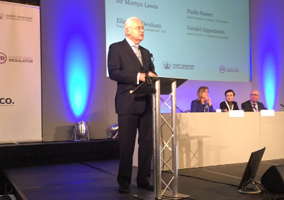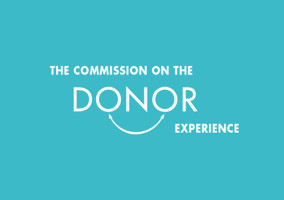David Ainsworth outlines his experience of working with the Comission on the Donor Experience.
I worked on a project for the Commission on the Donor Experience, which published its final report last week. I didn’t see eye to eye with them, if I’m honest. The project which bears my name has been heavily rewritten, and some of my key conclusions have been removed.
This isn’t totally unreasonable on their part, I have to say. My conclusions were wildly out of step with the direction of travel of the rest of the project, and they needed to project a vaguely unified approach.
I don’t disagree with anything the commission has put forward, either in my project or anyone else’s. But I personally wasn’t very interested in contributing to these recommendations. I wanted to say something else.
The core conclusion of the Commission on the Donor Experience is that if you should design all your processes to make the donor happy. I think anyone who follows the spirit and letter of the project recommendations will prove to be a good fundraiser, and probably make their charity a lot of money.
I agree with this as far as it goes, but two things made it problematic for me to contribute.
First, I think that while the CDE proposals will help some charities raise more, it will be at the expense of others. The total amount of charity fundraising will not be affected. If it does grow, relative to disposable income, it will be by only a very little bit.
The CDE wanted me to write, basically, that we should spend more money on fundraising if we want it to succeed. I think that while you should set long-term budgets, spend cash on measurement, and focus on proper training and technology. But I think the charity sector as a whole needs to find a way to spend less on fundraising.
Following from this, I don’t think that the behaviours the CDE proposes are the only ways of making the donor experience better. I think there are other, very important things that need to change. I approve of producing a guide to help individuals do well, but the real change we need is collective.
Why won't it make more money?
If you think about it, there has to be an upper limit to how much people will give to charity. People only have so much income, once the rent is paid and the kids are fed. They need to buy food and pay the bills and they're going to want a holiday each year and plenty of meals out with family and friends. So there's only so much of their income they feel willing to give.
The question is whether we have reached that level.
Now, charities already ask donors for money a lot. Very few people are not already presented with ample opportunity to give. So my theory is that most people are already giving what they’re comfortable with.
The data supports this. Research from Cass Business School has found no change in donation levels, relative to donor income, in the last 20 years. The UK Civil Society Almanac does not show fundraising income growing faster than disposable income.
My feeling is that many people – maybe most people – view charitable giving as a sacrifice. It is the size of their sacrifice which is really important to them. This, too, is borne out by the evidence. If you show that you can generate increased benefit to the charity - via Gift Aid, for example - you would expect people to change their behaviour dramatically. Few do.
So I think that for most people it's the amount they give that's important, not the charities they give it to. If they give more to one charity, they are likely to compensate by giving less to another.
This is not to say it is absolutely impossible to raise more cash. The CDE model wil have an effect. If you improve donors’ experience, they will give more.
But how much more? Not that much, probably. More likely they will just move their giving from those charities offering a poor experience, to those offering a good one.
The CDE's effect may not be on income at all, actually. After all, good treatment of donors is likely to read to increased retention. And while that might not drive up revenue, it may allow charities to spend less on acquiring it.
Spend less
This last is a key point. If I’m right, and you can’t grow the pot much, then all fundraisers are competing for the same money. Charities – particularly the largest charities – are investing fortunes in acquiring one another’s donors.
Curiously, fundraisers seem strangely resistant to the idea that they are already very good at their jobs, and have persuaded people to part with most of the cash they are willing to donate. Their preference is to believe that fundraising is very bad, and that people would give much more if only they were asked competently.
I am inclined to believe instead in the ability of fundraisers, and say that you have already cleverly exploited the most obvious opportunities, and that any new opportunity – unless it springs from a completely new and more efficient technology – is likely to come with a substantial cost attached.
It is in every charity’s interests to reduce the efficiency of fundraising, and reduce the cutthroat competition which has grown up since the start of the millennium.
All of this requires fundraisers to get together, and police their own industry.
One potential rule change might be for all fundraisers and fundraising bodies to be licensed. That would ensure that we’re inculcating good practice at an early stage, and also introduce a powerful incentive for people to continue with good practice – throwing them out of the profession if they misbehave.
Focus on collective impact
Fundraisers are not just spending more on fundraising. They are also getting in touch with donors a lot more often than they used to – roughly twice as often, according to Fundraising Standards Board statistics. It's led to a sixfold rise in complaints.
If we want to improve the donor experience, it is important to fundraise better. But fundamentally, it is the number of contacts, not their quality, which is most important.
If you cannot grow the pot much by contacting people more, it follows that it will probably not hurt to contact them a little less. So long as other charities do the same.
Fundraisers must set collective rules to reduce the number of times donors are approached, to avoid the feeling that the public. GDPR is likely to ameliorate this problem in the short term, but the fundraising community must manage the problem itself in the long term.
More broadly, it is all very well setting standards for best practice, but we cannot ignore that poor practice does work. Like it or not, many people have got rich by bombarding thousands of people with low-quality fundraising material.
If we truly want a sector focused on the donor experience, fundraisers cannot just act well themselves. They must prevent others acting badly.
Crucially, it is clear from many stories we've written that bad fundraising – hammering the phones, or incessant cold mailing – actually raises an awful lot of money. The trouble is that often it absorbs a lot of money, too - often going into the pockets of third-party agencies. Only a little reaches the charities and their beneficiaries.
So poor fundraising is not just ripping off donors, but ripping off other charities, too. If the size of the pot is limited, then the cash they raise comes directly from the pocket of your potential donors, and does not go into the pockets of your potential beneficiaries.
So fundraisers must act collectively to limit the effect of poor practice. The Fundraising Regulator and the ICO are outsiders. They cannot do this by themselves. The sector must own its own problems.











